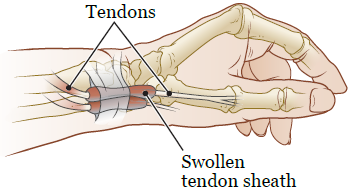This information explains what de Quervain’s tenosynovitis (da-KWUHR-vanes tee-na-sine-ah-VITE-us) is. It also describes some of its common causes and symptoms, and how it can be treated.
About De Quervain’s Tenosynovitis
De Quervain’s tenosynovitis is a common and painful condition that can affect the tendons in your wrist. Tendons are tissue that connects muscles to bones. A tendon sheath (protective covering) wraps around the tendons of your wrist so they can slide easily (see Figure 1).
This lets you turn your wrist, grip with your hand, and pinch with your fingers. With de Quervain’s tenosynovitis, your tendon sheath becomes swollen. This causes pain and limits how much you can move your wrist and thumb.

Figure 1. Wrist with de Quervain’s tenosynovitis
Causes of De Quervain’s Tenosynovitis
Some causes of de Quervain’s tenosynovitis are:
-
Doing the same wrist movements over and over, such as:
- Typing.
- Knitting.
- Using a hammer.
- Holding a baby for a long time.
- Carrying heavy grocery bags.
- Strain or injury to your wrist area.
- Health problems that cause swelling throughout your body, such as rheumatoid arthritis (ROO-muh-TOYD ar-THRY-tis). Rheumatoid arthritis is a disorder that causes swollen and painful joints.
Symptoms of De Quervain’s Tenosynovitis
Some symptoms (signs) of de Quervain’s tenosynovitis are:
- Pain at the side of your wrist, under the base of your thumb. Moving your thumb can make this pain worse.
- Wrist pain that has spread into your forearm and thumb.
- Mild (slight) swelling, redness, or warmth at your wrist.
- A fluid-filled cyst near the thumb side of your wrist. A cyst is a sac-like pocket of tissue.
Your healthcare provider can see if you have de Quervain’s tenosynovitis based on your symptoms and a physical exam. They will also ask you to do certain movements with your hand, wrist, and thumb.
Most people do not need to get X-rays of their wrist. Your healthcare provider will tell you if you do.
Treatment for De Quervain’s Tenosynovitis
There are treatments that can help ease the symptoms of de Quervain’s tenosynovitis. The amount of time it takes for symptoms to improve or go away is different for everyone.
Goals of treatment
The goals of treatment are to:
- Ease pain and swelling of your wrist.
- Keep the joints in your wrist working normally.
- Stop this condition from coming back.
Types of treatment
The type of treatment you get depends on how long you have had your symptoms. It can also depend on how bad your symptoms are. Talk with your healthcare provider about what treatments are best for you.
Depending on your symptoms, your healthcare provider may suggest:
Treatments to prevent more pain and swelling
-
Avoiding these things:
- Actions that cause pain in your thumb and wrist.
- Doing the same thumb and wrist movements over and over.
- Pinching your fingers while moving your wrist.
- Wearing a splint. A splint is a support device that protects your thumb and wrist and keeps them from moving. It keeps your thumb and wrist in a neutral position (not bent up or down) that does not cause strain. Your healthcare provider will tell you how to wear your splint.
Treatments to ease pain and swelling
-
Taking nonsteroidal anti-inflammatory drugs (NSAIDs). Common NSAIDs are:
- Ibuprofen (Advil®, Motrin®)
- Naproxen (Aleve®, Naprosyn®)
- Celecoxib (Celebrex®)
- Meloxicam (Mobic®)
- Diclofenac (Voltaren®)
NSAIDs may cause side effects. Ask your healthcare provider if they are safe for you to take.
- Getting steroid injections (shots) into your wrist. Steroid shots are used if your pain does not go away after trying other treatments. These shots may help with the pain and swelling for a few weeks or months.
-
Putting ice or heat on your wrist. Your healthcare provider will tell you which one to use.
- When using ice:
- Place an ice pack or cold pack on your wrist for 10 minutes. Do not keep it on your wrist for more than 10 minutes at a time. Keeping it on for longer than 10 minutes may damage your tissues (tendons).
- Repeat every 4 to 6 hours.
- When using heat:
- Place a warm water bottle or heating pad on your wrist for 15 minutes. Do not keep it on your wrist for more than 15 minutes at a time. Make sure the warm water bottle or heating pad is not too hot before putting it on your wrist. Be careful not to burn yourself.
- Repeat every 4 to 6 hours.
- When using ice:
-
Working with a physical therapist (PT) or occupational therapist (OT). Your healthcare provider may suggest that you work with a PT or OT who will:
- Show you how to do your daily activities while wearing a splint.
- Help you change your home and work activities to ease the stress on your wrist.
- Teach you exercises to make your arm, wrist, and hand stronger as you heal.